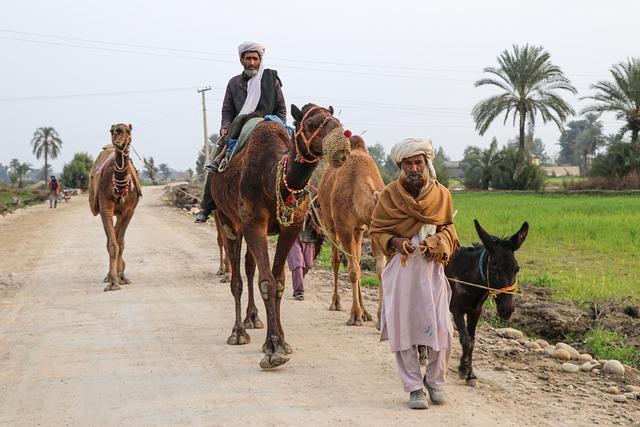In an increasingly interconnected world, the movement of people transcends borders, weaving intricate tapestries of cultures, ideas, and economic potential. Among these global networks, Pakistan stands out, as its diaspora has been a significant player in shaping not only the narratives of their host countries but also the socio-economic landscape of their homeland. In “Exploring Immigration Trends: Pakistan’s Diaspora and Opportunities,” we delve into the evolving patterns of migration from Pakistan, examining the motivations behind this movement, the diverse communities that have emerged abroad, and the myriad opportunities that arise from this global presence. As we uncover the stories and statistics that define this diaspora, we invite you to consider how these trends not only reflect the struggles and aspirations of individuals but also speak to the broader challenges and possibilities facing both Pakistan and the world at large.
Understanding the Historical Context of Pakistans Migration Patterns
The narrative of migration in Pakistan is deeply intertwined with its rich and complex history, a tapestry woven with socio-political dynamics and economic necessities. Significant migration waves can be traced back to the partition of British India in 1947, when millions crossed borders and disrupted lives, laying the groundwork for future diasporas. Since then, various factors have motivated migration, including political instability, economic disparity, and educational opportunities. Moreover, the Gulf states have become prominent destinations for Pakistani labor migration, driven by demand for skilled and semi-skilled workers, which has shaped not only remittance flows but also the socio-economic landscape of Pakistan. This historical backdrop is crucial in understanding how current migration patterns have evolved and diversified over the decades.
In recent years, trends have shifted from mere labor migration to a more multifaceted approach that includes students pursuing higher education abroad and professionals seeking specialized opportunities. The emergence of a highly educated and tech-savvy younger generation has paved the way for brain drain, as many seek to establish careers in developed nations. The following table encapsulates some significant migration trends in Pakistan over the last decade:
| Year | Population Migration | Key Destinations |
|---|---|---|
| 2010 | 1.5 million | Middle East, UK |
| 2015 | 2 million | Gulf States |
| 2020 | 2.5 million | Canada, Australia, USA |
| 2023 | 3 million | Europe, Middle East |
This table illustrates not just the migratory numbers but also highlights changing destinations, reflecting the globalized nature of labor and the aspirations of more educated Pakistani youth. Understanding these patterns is integral for policymakers, as they can leverage this knowledge to create frameworks that benefit both the emigrants and the nation as a whole.

The Economic Impact of Pakistani Diaspora: Contributions and Challenges
The Pakistani diaspora, estimated at around 9 million globally, has become a vital source of economic support for the homeland. Through remittances, they contribute significantly to the national economy. In the fiscal year 2022-23, remittances from overseas Pakistanis reached approximately $31 billion, playing a crucial role in poverty alleviation and boosting local consumer markets. Additionally, the talents and skills of the diaspora enhance human capital through knowledge transfer, investments, and entrepreneurship. Many Pakistani expatriates are not just sending money home; they are also pioneering initiatives and starting businesses that generate employment opportunities and foster innovation.
However, the journey of the diaspora is not without its challenges. Factors such as economic instability in Pakistan, changes in foreign immigration policies, and social integration issues in host countries can hinder their contributions. Moreover, the frequent fluctuation of exchange rates can affect the value of remittances. The diaspora faces a dual challenge: while they wish to maximize their impact back home, they must also navigate the complexities of their new environments. As Pakistan seeks to leverage the potential of its diaspora, a more comprehensive strategy is necessary to enhance engagement, create favorable conditions for investment, and promote social welfare in both Pakistan and host nations.
| Year | Remittances (in Billion $) |
|---|---|
| 2020-21 | 29.4 |
| 2021-22 | 31.2 |
| 2022-23 | 31.5 |

Navigating the Path to Global Integration: Skills and Opportunities for Pakistani Immigrants
As Pakistani immigrants carve their niche across the globe, acquiring a specific set of skills can significantly enhance their prospects for successful integration and professional growth. Language proficiency in the host country’s dominant language is foundational, facilitating communication and community engagement. Additionally, cultural awareness aids in understanding social norms and workplace etiquette, enabling immigrants to establish meaningful connections. Technical skills tailored to the demands of local job markets, such as IT, healthcare, and engineering, open doors to diverse career paths. Other vital skills include adaptability, networking abilities, and an entrepreneurial mindset, which can be instrumental in navigating new environments.
Opportunities for Pakistani immigrants are abundant, particularly in sectors experiencing growth. Various industries actively seek talent with cross-cultural competencies, making Pakistani professionals valuable assets. Key areas of opportunity include:
- Information Technology: With an increasing global reliance on digital solutions, tech professionals are in high demand.
- Healthcare: As many countries face shortages in healthcare professionals, nursing and medical roles present significant prospects.
- Agriculture: With expertise in unique farming practices, immigrants can contribute to agricultural advancements.
| Industry | Opportunities | Skill Area |
|---|---|---|
| Information Technology | Software Development, Cybersecurity | Coding, Network Security |
| Healthcare | Nursing, Medical Research | Patient Care, Analytical Skills |
| Education | Teaching, Curriculum Development | Communication, Teaching Methodologies |

Policy Recommendations for Enhancing Diaspora Engagement and Development
To strengthen the links between Pakistan’s diaspora and their homeland, it is imperative to implement policies that promote active engagement and investment in local development initiatives. Encouraging return migration through tailored reintegration programs can help create a skilled labor pool that contributes to economic growth. Additionally, establishing diaspora networks that facilitate knowledge transfer and mentorship opportunities can foster innovation. Key recommendations include:
- Creating a national diaspora engagement strategy focused on building connections and partnerships.
- Offering incentives for diaspora members to invest in local enterprises and development projects.
- Facilitating easier channels for diaspora remittances that support community-based initiatives.
Moreover, the government should leverage technology to enhance communication between expatriates and their local communities. Digital platforms can serve as valuable tools for diaspora members to offer their expertise, contribute to policy dialogues, and support grassroots movements. Furthermore, establishing a Diaspora Advisory Council can ensure that voices from diverse segments of the diaspora are represented in national development strategies. Vital areas for consideration include:
- Developing online platforms for knowledge sharing and mentorship programs.
- Creating fiscal policies that support philanthropic efforts directed toward education and healthcare.
- Implementing cultural exchange programs to maintain a strong cultural identity among the diaspora.
Concluding Remarks
As we conclude our exploration of immigration trends surrounding Pakistan’s vibrant diaspora, it becomes clear that these journeys are much more than mere relocations—they are threads woven into the rich tapestry of global interconnectedness. The multifaceted experiences of Pakistani migrants reveal not only the challenges faced but also the immense opportunities that arise from such transitions.
From the bustling streets of Karachi to the cosmopolitan hubs of London, New York, and beyond, the stories of resilience, innovation, and cultural exchange continue to shape the narrative of diasporic identity. Each individual adds to the collective wealth of knowledge and perspective, bridging cultures and fostering understanding in a world that often feels divided.
As we look ahead, it remains imperative to recognize the potential locked within this dynamic diaspora, advocating for policies and initiatives that harness their talents for mutual benefit. Engaging with local communities and nurturing transnational ties can pave the way for not only economic growth but also enriched cultural dialogues that celebrate diversity.
In reflecting on the journey of Pakistan’s diaspora, we find a timeless reminder: that migration is not merely an act of leaving, but a powerful catalyst for growth and opportunity, reminding us that sometimes, to move forward, we must first take a step beyond borders.



